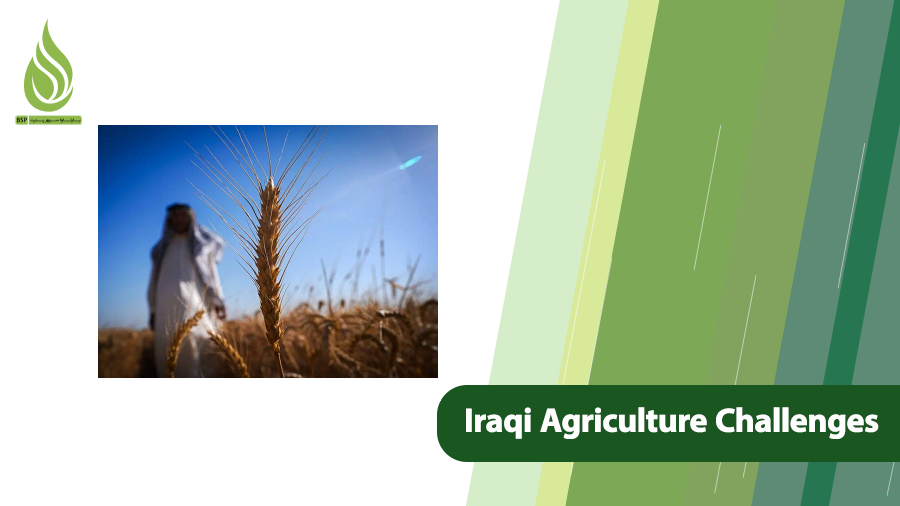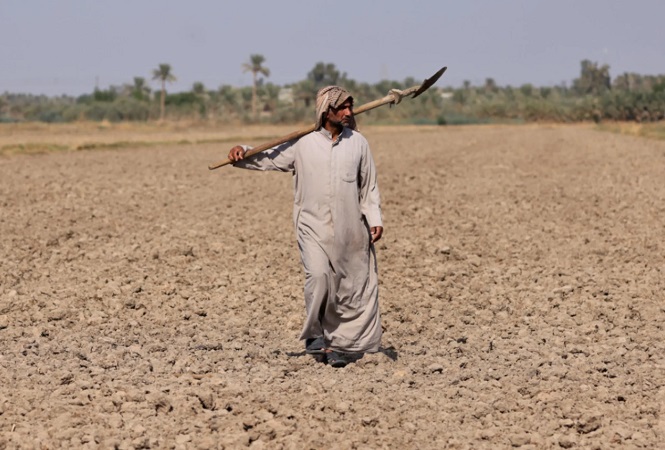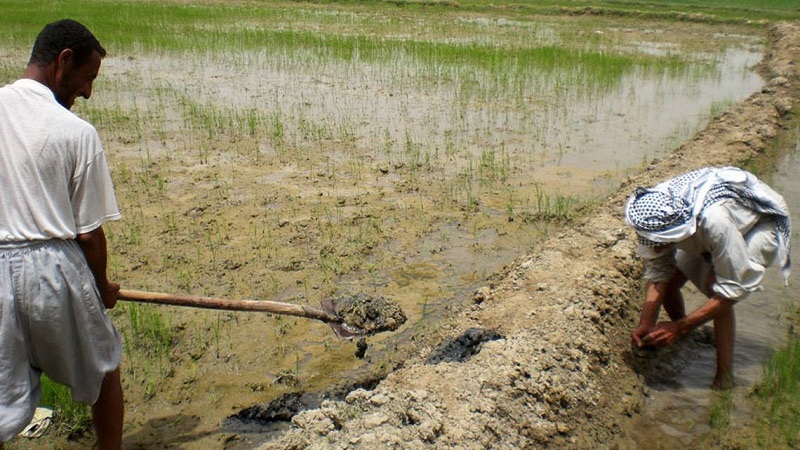
Challenges of Iraqi Agriculture and Their Solutions
Agriculture is a cornerstone of Iraq’s economy and the livelihood of its people. It ranks as the second-largest source of income in the country, following oil and energy. Iraq produces crops such as wheat, barley, vegetables, and fruits like dates and olives, contributing to both domestic food supply and exports. However, agricultural challenges in Iraq have created significant obstacles for farmers. Factors such as climate change, water scarcity, and soil salinity are among the primary challenges facing Iraqi farmers. Improving and developing agriculture in Iraq not only supports people’s livelihoods but also fosters sustainable economic growth. In this article, we explore the challenges of Iraqi agriculture and their potential solutions.
What Are the Challenges of Iraqi Agriculture?
Iraq is one of the world’s leading producers of dates, renowned for their exceptional taste and quality. In addition to dates, crops like wheat and barley are cultivated in Iraq. Other agricultural and orchard products include pistachios, olives, pomegranates, rice, vegetables, corn, millet, sugarcane, sugar beets, fruits, fodder, and cotton. However, growing and maintaining these crops comes with challenges and limitations.
According to previous reports from Iraq’s Ministry of Agriculture and Ministry of Planning, the amount of cultivated land in Iraq has significantly decreased in recent years. This decline stems from several major reasons, which we will examine below.
Water Scarcity (Iraq’s Most Critical Agricultural Challenge)
One of the greatest challenges in Iraqi agriculture is water scarcity. Climate change and reduced rainfall have put pressure on water resources, leading to decreased agricultural output. Iraq was once among the most water-rich countries in the Middle East, with the Tigris and Euphrates rivers flowing through it, along with several streams and lakes. Despite this, the country now faces water shortages. The main causes of water scarcity in Iraq include reduced rainfall and dam construction by upstream countries like Turkey, which restricts river flows. In recent years, deserts and sand have rapidly encroached on cities and areas that were once lush and green.

Desertification in Iraq
Desertification refers to the process of fertile land degrading and transforming into desert areas. In Iraq, this phenomenon has occurred due to reduced rainfall, climate change, mismanagement of water resources, overgrazing by livestock, loss of vegetation cover, war, and the destruction of infrastructure.
Increased Soil Salinity
The rising salt content in soil, or soil salinity, is a major challenge for Iraqi agriculture. This issue is particularly problematic in the central and southern regions of the country. Causes of soil salinity include high evaporation rates, low rainfall, irrigation with saline water, inadequate drainage, and the rising level of salty groundwater.

Lack of Resources
The shortage of essential resources such as high-quality fertilizers, pesticides, agricultural machinery, and drip irrigation tools is a significant challenge for Iraqi agriculture. By providing loans to farmers or having the government supply their needs, Iraq’s agricultural sector could see substantial improvement.
Excessive Agricultural Imports (A Major Challenge for Iraqi Agriculture)
The underactive agricultural sector and excessive imports of agricultural products have led to reduced domestic production, prompting farmers to consider migrating from rural areas and seeking new livelihoods. Many imported agricultural products are ones that Iraq can cultivate and previously supplied through domestic farming. Redirecting the budget spent on imports to stay within the country and reach Iraqi farmers could strengthen agriculture.
Soil Erosion and Declining Land Fertility
In many agricultural regions of Iraq, soil has become severely eroded. Factors contributing to this include repeated planting without crop rotation, overuse of heavy machinery, and the loss of organic soil matter. This issue has significantly reduced agricultural productivity.
Other Challenges Facing Iraqi Agriculture Include:
- Environmental Degradation: Soil and water pollution, along with the overuse of chemical pesticides and fertilizers, have harmed the environment and lowered the quality of agricultural products.
- Lack of Modern Technology: Agriculture in Iraq largely relies on traditional methods. Most Iraqi farmers lack access to modern technologies and advanced agricultural tools. Many do not even use drip irrigation systems, instead relying on surface irrigation. Seed improvement, pest control, and proper fertilization also require major reforms.
- Limited Market Access: Poor infrastructure and inadequate access to markets prevent farmers from selling their products, leading to reduced income. The lack of transportation infrastructure, cold storage facilities, and warehouses poses significant barriers to farmers’ ability to market their goods.
- Political and Security Issues: Political instability and conflicts in some regions have discouraged investment in agriculture and reduced production.
- Labor Shortages: Young people, facing unstable income from farming, have migrated to cities. This has led to an aging farming population and a shortage of agricultural workers.
- Weak Government Oversight: The absence of a strategic agricultural plan and ineffective enforcement of regulations are major challenges.

Proposed Solutions to Improve Iraqi Agriculture
So far, we’ve discussed the challenges facing Iraqi agriculture. Now, let’s explore solutions to address these obstacles.
- Water Resource Management: Traditional irrigation methods not only waste water but can also harm plants and tree roots in some cases. To manage water effectively, developing efficient irrigation systems and adopting modern technologies like drip and sprinkler irrigation is essential. Restoring wetlands and rivers to stabilize ecosystems and maintain soil moisture, as well as treating and recycling urban and industrial wastewater for agricultural use, are additional strategies for sustainable water management.
- Support for Research and Innovation: Given changing climate conditions, the Iraqi government should invest in agricultural research. This would help identify and invest in crops that are resilient to climatic challenges.
- Financial and Credit Support: Providing farmers with access to loans and financial assistance is critical for improving production. The government should offer subsidies to make purchasing fertilizers, seeds, and other essentials more affordable. Establishing an insurance system to protect farmers from losses due to natural disasters and market fluctuations is also recommended.
- Farmer Education and Empowerment: Organizing training programs for farmers on modern agricultural techniques, farm management, and efficient resource use is highly recommended.
- Infrastructure Development: To improve farmers’ access to markets and reduce distribution costs, transportation and market infrastructure must be developed.
- Increasing Vegetation and Reforestation: To prevent soil erosion, planting salt- and drought-resistant plants and trees, such as eucalyptus, is advised. Creating green belts around cities and farms to block encroaching sand, along with developing managed pastures and controlling overgrazing, is also recommended.
- Enhancing Soil Organic Matter: Using organic fertilizers can increase soil organic matter, helping to retain moisture and maintain soil fertility.

Solutions to Address Soil Salinity
One of the primary challenges in Iraqi agriculture is soil salinity. Many crops grown in Iraq are resistant to salinity, but the alkalinity and salt levels in the soil must still be controlled. Several strategies are recommended to achieve this:
Improving Drainage Systems
- Construct and repair underground drainage channels and networks to prevent salt accumulation in the soil and facilitate salt removal.
- Use surface drainage in areas with heavy soil.
Soil Texture Improvement
- To improve soil texture, add gypsum (calcium sulfate) to the soil, displace sodium ions,s and reduce salinity effects.
- Apply organic materials (such as mulching, well-rotted manure, or compost) to increase the soil’s water-holding capacity and mitigate the impact of salts.
Using Salt-Tolerant Plants
- Cultivate salt-tolerant plants like barley, sugar beets, sesame, or date palms, which have high tolerance to salinity.
- Conduct local research to identify and develop genetically improved salt-resistant seeds.
Irrigation Management
- Irrigate at optimal times (such as early morning or evening) to reduce evaporation.
- Use fresh water to lower soil salinity or irrigate with low-salinity water instead of purely saline water.
Importing Essential Agricultural Fertilizers
Fertilization with appropriate fertilizers is a key method for boosting productivity alongside other measures. To this end, importing high-quality and essential fertilizers from countries like Iran is advisable. Given Iraq’s climatic conditions (hot and dry), soil characteristics (saline and alkaline), and nutrient deficiencies in many regions, certain fertilizers are particularly critical. Below, we outline the most important and necessary fertilizers for Iraqi agriculture, along with their applications:
Nitrogen-Based Fertilizers (N)
Iraqi agricultural soils are typically nitrogen-poor. Nitrogen is essential for rapid growth, leaf production, plant protein synthesis, and high yields. One of the best nitrogen fertilizers for Iraqi agriculture is crystalline and granular ammonium sulfate. In saline soils, ammonium sulfate performs better than other nitrogen fertilizers. Many areas in Iraq face soil salinity and alkalinity (high pH). Ammonium sulfate creates a mildly acidic environment around plant roots, helping to reduce soil alkalinity and improve nutrient uptake. Nitrates are more easily leached in saline soils, but ammonium is more stable and better absorbed by plants. Therefore, ammonium sulfate is a more suitable option than nitrate-based fertilizers for Iraq’s saline soils.

Phosphate Fertilizers (P)
Phosphorus is crucial for root growth, flowering, and improving product quality. In alkaline soils, phosphorus becomes unavailable to plants, so it must be supplied through fertilization. Ammonium phosphate, simple superphosphate, or triple superphosphate are examples of phosphate fertilizers.
Potash Fertilizers (K)
Potash fertilizers include potassium chloride and potassium sulfate. In Iraq’s saline soils, potassium sulfate is preferable to potassium chloride, as excess chloride can harm plants. Potassium enhances plant resistance to drought, salinity, and pests.
Sulfur-Based Fertilizers (S)
Sulfur fertilizers help reduce soil alkalinity. They are also essential for protein production and improving nitrogen uptake. Iraqi soils are typically deficient in sulfur. The best sulfur fertilizer, which also contains nitrogen, is ammonium sulfate.
Micronutrient Fertilizers
Micronutrients include iron, zinc, manganese, magnesium, copper, and boron. In Iraq’s alkaline and calcareous soils, plants have very limited access to these elements. Deficiencies in these micronutrients cause leaf yellowing, reduced fruit production, and overall plant weakness.
